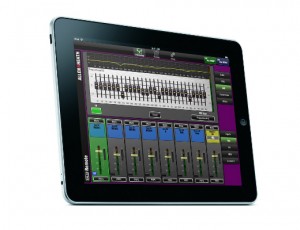Allen & Heath Launches GLD Remote — Wireless Live Mixing App for iPad
The availability of live sound mixing tools that operate wirelessly via the iPad continue to expand.
Allen & Heath has launched the latest option, GLD Remote, a free download that accompanies their cost-effective and scalable GLD-80 mixer. Originally shown at NAMM 2013, the app is now out in the open, providing a comprehensive suite of mixing controls for remote wireless applications using the iPad or the iPad Mini.
Here’s more from Allen & Heath on the GLD Remote (enjoy the King’s English!), which is available now and, as we said, FREE of charge:
GLD Remote connects to the GLD-80 mixer on a wireless network and gives the user instant access to any of the mixers channel faders and mutes, DCA faders and mutes, image controls, aux sends and assignments as well as channel input and output processing, mic-pre control and full metering. Whereas most other apps on the market offer limited control over the channel processing, GLD Remote gives control of high pass filters, gates, parametric and graphic EQ, compressors and input/output delays.
Other unique features for system setup include a real time analyser (RTA) to ring out monitors and EQ the PA, the facility to name and colour channel strips, custom layers with drag ‘n drop strip setup to suit any application, and a mix view where monitor engineers can keep both master levels and contributions under control in a single screen. Additionally, GLD Remote provides channel PFL control to enable the engineer to remotely listen to feeds using a wireless monitor system.
R&D director, Rob Clark, commented: “GLD Remote unlocks comprehensive wireless control of processing and mixes resident in the GLD-80, ranging from monitor mix stage setup, venue roaming and PA tweaking, and secondary control applications for fixed installs. During set up, engineers can walk around a venue and individually mute or apply level, processing and delay changes to the PA, and discreetly mix from anywhere in the venue during the show, whilst monitor engineers will appreciate being able to balance monitors from the musician’s position on the stage.”
Please note: When you buy products through links on this page, we may earn an affiliate commission.








ครูช่าง ซังกะบ๊วย
March 4, 2013 at 9:17 pm (12 years ago)when complete?